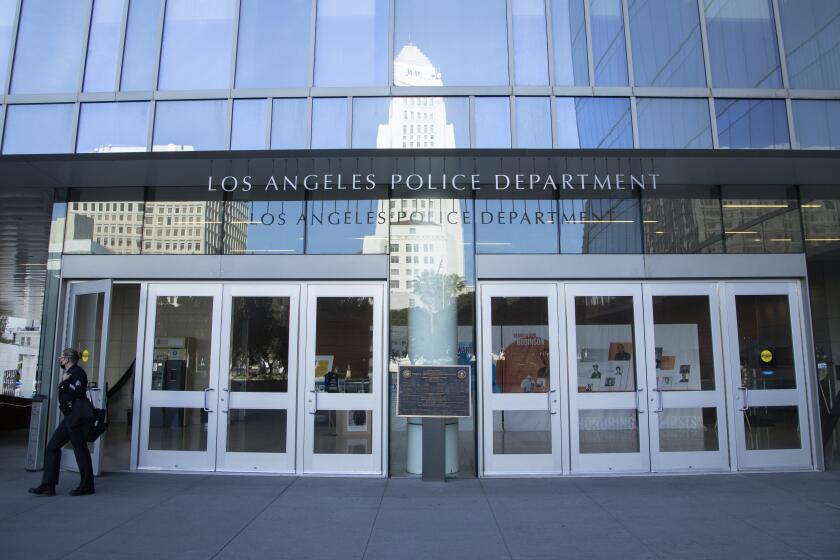NTSB: Asiana jet well below target speed, speeding up at impact
SAN FRANCISCO — The Asiana Airlines jetliner that crash-landed at San Francisco International Airport had fallen more than 30 knots below target landing speed just seconds before it crashed, but both its engines were revving up at the time of impact, federal accident investigators said on Monday.
At a news conference Monday morning, Deborah A.P. Hersman, chairwoman of the National Transportation Safety Board, detailed the descent speed of the plane in the moments before the crash that killed two and wounded dozens more.
At 1,600 feet and 82 seconds prior to impact, autopilot was disengaged. The NTSB will interview all four pilots aboard the aircraft on Monday, Hersman said, and plans to ask them how much they relied on automation and whether they understood the technology.
At 500 feet and 34 seconds before impact, the plane dipped below target landing speed of 137 knots to 134 knots.
Speed continued to decrease as the plane continued its decent. At three seconds prior to impact, the flight data recorder “recorded its lowest speed, of 103 knots,” Hersman said. Engines at the time were at about 50% power and engine power was increasing. At impact, air speed was 106 knots, she said, meaning it was speeding up.
“We’re looking at what [the crew was] doing and why they were doing it,” Hersman said. “We want to know what they understood.”
Monday, Hersman also confirmed that the pilot of the Asiana plane did not have his rating, or certification, to fly the Boeing 777 and that the other pilot in the cockpit was a training captain. The pilot was “working on getting initial operating experience on a triple-seven,” she said.
She said there were four pilots, including the trainee, onboard, and the airport and plane charts used for flight and landing were in proper positions.
Two other crew members — a captain and a first officer—were onboard to provide relief for the pilots, as is normally required during trans-Pacific flights, Hersman said. The FAA restricts the number of hours pilots can fly without a break, and crews are given a rest area inside the plane to nap when they are not flying. There is no reason to believe the pilots did not take turns resting and working, Hersman said.
Pilots were asked to increase the speed of the aircraft about seven seconds before impact, officials said Sunday. Four seconds before impact, an instrument that warns pilots of an impending stall began to vibrate loudly and rapidly. About 1.5 seconds before the crash, the crew gave the order to abort the landing, turn around and try again.
A spokeswoman for Asiana Airlines in South Korea told The Times late Sunday that the pilot of the plane, Lee Kang-kook, had only 43 hours of experience flying Boeing 777s. Lee has been flying since 1994 and is a “very experienced pilot” with other types of planes, including Boeing 747s, 737s and A320s, said spokeswoman Lee Hyo-min.
But “he was in training for B777,” she said, adding that he had 9,793 hours of flight time. She said Lee had traveled to San Francisco International previously, “but with B777, not much.” She would not specify whether Saturday’s flight was the pilot’s first to SFO in a 777.
She identified the co-pilot as Lee Jung-min, who has logged more than 12,000 flight hours. “He had lots of experience with the B777,” the spokeswoman said.
Hersman said she was reluctant to speak to what training was required to transition from the Boeing 747 to the Boeing 777 until agents have finished interviewing the four crew members about their training, experience and observations during the flight.
“We do not want to bias those interviews that are contemporarily taking place right now,” Hersman said. “We do not want to influence the responses.”
Flight 214 had been cleared by Northern California TRACON for a 17-mile, straight visual approach to the airport, officials said. Communication was passed to SFO air-traffic control tower operators, who heard no distress calls or any other indication that something had gone wrong. Controllers help aircraft avoid each other in the air and on the runway, officials said, but successfully landing the plane is the responsibility of the pilot.
The NTSB will look at other flights that used the same runways, nearly two miles long, in days before the accident, Hersman said. The airport was renovating the runways to move the landing area closer to the terminal buildings. Officials had told pilots that, as a result, some flight-aids, including a tool that helps control the plane’s descent angle, would be disabled until Aug. 22.
Hersman also said Monday that there was no “abnormally steep descent curve” to the plane’s approach.
Some passengers and flight attendants have told investigators that evacuation chutes on the left-hand side of the plane inflated, improperly, into the inside of plane. The NTSB continues to investigate, Hersman said.
Investigators are combing through all aspects of the crash, including the crash site. The lower portion of the plane’s tail cone is on the rocks at the sea wall, officials said, and a “significant piece” of the tail is in the water. More pieces of the airplane are visible in the water when the tide goes out.
On the beginning of the tarmac, investigators found the horizontal stabilizer, the vertical stabilizer and the upper portion of the tail cone. Farther down Runway 28L, investigators have documented pieces of the landing gear and fractured pieces of the aft fuselage, as well as sea wall debris several hundred feet away from the wall.
In Washington, D.C., House Transportation Committee Chairman Bill Shuster (R-Pa.) and Aviation Subcommittee Chairman Frank LoBiondo (R-N.J.) said in a written statement Monday that they are monitoring the NTSB investigation and will “review the board’s findings and any recommendations to ensure the appropriate measures are in place to protect airline passengers flying into and out of our airports.”
“The United States’ aviation system is the safest in the world, but as Saturday’s incident demonstrates, we must always remain vigilant and work to ensure the system remains as safe as possible,’” the statement said.
The new information comes a day after NTSB investigators said the jetliner was on the verge of stalling before the aircraft clipped the sea wall and slammed into the runway.
On Sunday, Hersman said there was a call in the cockpit to increase speed seven seconds before the plane’s tail struck the sea wall that separates the airport’s runway from the bay. According to onboard flight and voice recorders, the pilots received a warning four seconds before impact that the aircraft was approaching a stall — a speed so low it can no longer generate enough lift to stay aloft.
At 1.5 seconds before impact, there was a call for the plane to abort the landing and circle around, Hersman said. By then it was too late, as the jetliner crashed and broke apart, killing two passengers and injuring dozens of others. The plane was carrying 307 people.
Asked Sunday whether pilot error may have been a factor, Hersman said: “Everything is on the table right now. Nothing has been ruled out.”
ALSO:
NTSB official offers new details on S.F. plane crash
Dramatic photos from inside Asiana plane after it crashed
First responders to Asiana crash tell of race to rescue passengers
Times staff writer Richard Simon contributed to this report.
More to Read
Start your day right
Sign up for Essential California for news, features and recommendations from the L.A. Times and beyond in your inbox six days a week.
You may occasionally receive promotional content from the Los Angeles Times.









